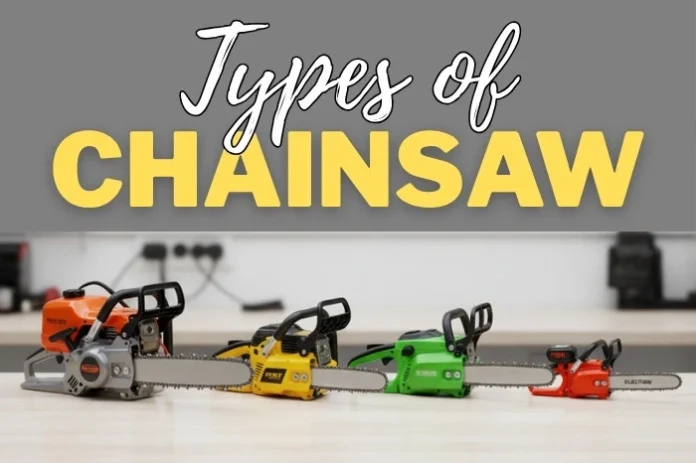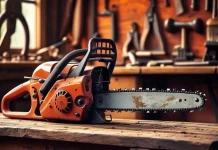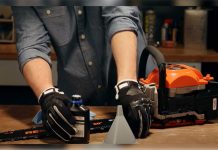If you cut wood, prune trees, or clear storm damage, you know a bad saw shows itself fast. The right tool makes the whole job quicker, cleaner, and safer. I’ve spent years testing saws on real jobs, from backyard cleanup to full tree service work. I’ve stood in the cold while batteries drooped, and I’ve changed mixed fuel in the heat. That hands-on time matters because it reveals the little things spec sheets hide. The good news is homeowners now have more choices than ever, and our team has examined all types of chainsaws to find the best of the best.
Why was Chainsaw Invented? Brief History
So, what were chainsaws invented for? Chainsaws started life as big, awkward tools used for logging and even medical work back in the 19th century. They progressively shrank and gained power until they became the handheld machines we know today. That history explains why we now have so many flavors of saw made for very different jobs.
Types of Chainsaws for Homeowners and Professionals
Below, I list the practical types you will see at the store or on job sites, what each does best, and the top picks I’d reach for in real work.
- Petrol chainsaw
- Gas chainsaw
- Electric chainsaw
- Mini chainsaw
1. Petrol chainsaw
Petrol chainsaws use a two-stroke engine and mixed fuel. It is best for felling medium to large trees, heavy bucking, and long days on a property with no power outlets nearby. I’d choose it if I need to refuel in under a minute and I want to keep going. For large or commercial jobs nothing else beats the raw runtime and bar length variety. Tech reviewers and pro arborists still point to gas saws for maximum cut capacity and quick refuel time.
The tradeoffs are noise, emissions, and extra maintenance.
Top petrol picks
- Husqvarna 455 Rancher – It is great all-around and offers reliable power for landowners.
- ECHO CS-590 Timber Wolf – Its big cylinder and serious cut speed are ideal for heavy-duty jobs.
- Stihl MS 180 C-BE – It is lightweight, very easy to start, and a trustworthy chainsaw.
2. Gas chainsaw
Do you also use petrol and gas interchangeably? I list gas separately since that wording comes up a lot. If you mean the same as petrol, see the petrol list above. If you mean consumer-grade or pro-grade gas saws, here are gas models that perform well by category.
My top gas picks for pro-level or heavy yard work:
- Husqvarna 550 XP – This pro grade machine is built for tough timber.
- Husqvarna 450R – Want a dependable mid-size saw for bigger cuts? Use 450R for a good mix of runtime and portability.
- Husqvarna 3120 XP – it is the biggest chainsaw in the world right now, with a bar length of up to 42 inches.
3. Electric chainsaws
You can choose from corded models that plug into an outlet or battery-powered models that use lithium packs. They work best for residential trimming, firewood for a small stove, and cleaning up storm debris near the house. I like them for being quiet, low vibration, and low maintenance. Modern battery saws have gotten shockingly good. I have found in side-by-side testing that some top battery models beat gas saws on pure cut time.
Top electric picks
- EGO Power+ CS2005 (20 in) – this top battery performer cuts fast and has a mature battery ecosystem.
- DEWALT 60V FLEXVOLT 18 in – The Dewalt is a trusted brand, and this one is their powerful cordless option.
- Makita UC4051A – This corded electric punches above its weight for cutting and price.
- Greenworks Pro 80V – this saw is recommended for runtime and professional features.
4. Mini Chainsaw
These are small, handheld with 4 to 8 inch bars, and are usually battery powered. I prefer them for pruning, camping, trimming small limbs, or when I want one-handed light cutting. They are not for felling trees, but they are fast and convenient for backyard tasks.
Top mini picks
- Seesii Mini Cordless – this option is light and a best seller for quick yard work.
- Saker Mini Portable – of course, it is lightweight, and probably that is the reason for its popularity.
- TIETOC Mini Chainsaw – If found, this small saw has a very strong rating on Amazon.
Buying tips for the Best Chainsaw
You should always match bar length to the task. Short bars are lighter and safer for pruning. Long bars let you cut big rounds but are heavier and more tiring. Each requires sharpening for optimum performance as well as oiling to prevent wear and tear.
Consider runtime vs recharge. Gas refueling takes a minute. Batteries can take anywhere from 30 minutes to several hours to top up. I have measured runtimes and found gas often lasts longest in continuous minutes, but big batteries can deliver a lot of cuts per charge.
Safety should be the top priority. Wear a helmet, eye protection, chaps or protective trousers, gloves, and hearing protection. Never cut above shoulder height and keep a clear work area. These are basic pros to follow every time.
Final Thoughts
For me, the best type of chainsaw is less about the brand hype and more about matching the tool to the work. If you only prune and clean up around a house, an electric saw will serve you well. If you run a crew or manage raw timber, petrol or gas will keep you moving. Mini saws are great for odd jobs, and they get pulled out of the shed more often than you might think. I’ve tested these models in real conditions and the picks above are the ones I would reach for when the work gets real.





